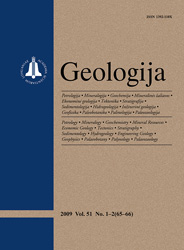Geologija / Geology
WHAT?
 ISSN 1392-110X ISSN 2029-056X (online) |
2008 m. Nr. 2 Importance of allotigenic accessory elements in factor loading matrix as statistical expression of geochemical composition variation in soils of different age
The longer duration of weathering and climate changes have caused a relative enrichment of soil by weathering-resistant heavy minerals and allotigenic accessory elements Y, Yb, La, Ti, Zr, Nb (AAE) bound to them. For this study, particular Lithuanian soil regions where soils have been formed on sediments of the last but one glaciation and various deglaciation phases of the last glaciation, and where the highest content of AAE was found were selected. In each region, links between the importance of AAE in the factor loading matrix (AAE importance) and soil age, content of clay based on its content in differently grain-sized soil types and soil anomalousness were evaluated. Analytical results of the <1 mm soil fraction obtained by atomic emission spectrophotometry for the Lithuanian geochemical atlas were used for this study. In each soil region, sandy, sandy-loamy and loamy-clayey soils were studied without classifying them according to the genesis of soil-forming sediments but dividing according to their anomalousness. Factor analysis was applied for primary, anomalous and un-anomalous data. For evaluating AAE importance, only associations of the first three factors with the total percentage of variance more than (or cloze to) 50 were considered. The applied significance level for factor loading was 0.01. The importance of AAE was evaluated taking into account the rank of the factor (according to factor variance percentage), the values of significant AAE loadings on the factor and the proportion of AAE and other trace elements in the group with significant factor loadings. In soils of the Ašmena Highlands, which are the oldest in Lithuania, the importance of AAE is in inverse ratio with clay content in soil. In soils of the Lower Nemunas Plain, which are younger than soils of the Ašmena Highlands, the importance of AAE is in direct ratio with the content of clay and soil anomalousness. With an increase of clay content, the importance of AAE increases both in un-anomalous and in anomalous soils. In soils of the Mūša–Nemunėlis Plain, formed on the youngest soil-forming sediments of Lithuania, both in primary and anomalous soils the first factors are formed by mixed associations of AAE and allotigenic elements (AE), where the importance of AAE decreases with an increase of clay content in soil. Age differences of soils formed on glacial sediments of the last but one and the last glaciation are mostly revealed through links between AAE importance and clay content in soil. The differences of AAE importance in soils formed on sediments of different phases of the last glaciation are mostly related to more distinct changes of the factors with which AAE correlate, and purer AAE associations in soils of the Lower Nemunas Plain than in soils of the Mūša–Nemunėlis Plain. Keywords: allotigenic accessory elements, age of soil-forming sediments, geochemical variation, factor analysis, importance in factor loading matrix |
Issues:
2011 - Vol.53 No. 1, No. 2, No. 3 2010 - Vol.52 No. 1-4 2009 - Vol.51 No. 1-2, No. 3-4 2008 - Vol.50 No. 1, No. 2, No. 3, No. 4, No. Priedas 2007 No. 1, No. 2, No. 3, No. 4 2006 No. 1, No. 2, No. 3, No. 4 2005 No. 1, No. 2, No. 3, No. 4 2004 No. 1, No. 2, No. 3, No. 4 2003 No. 1, No. 2, No. 3, No. 4 2002 No. 1, No. 2, No. 3, No. 4 2001 No. 1, No. 2, No. 3, No. 4 |